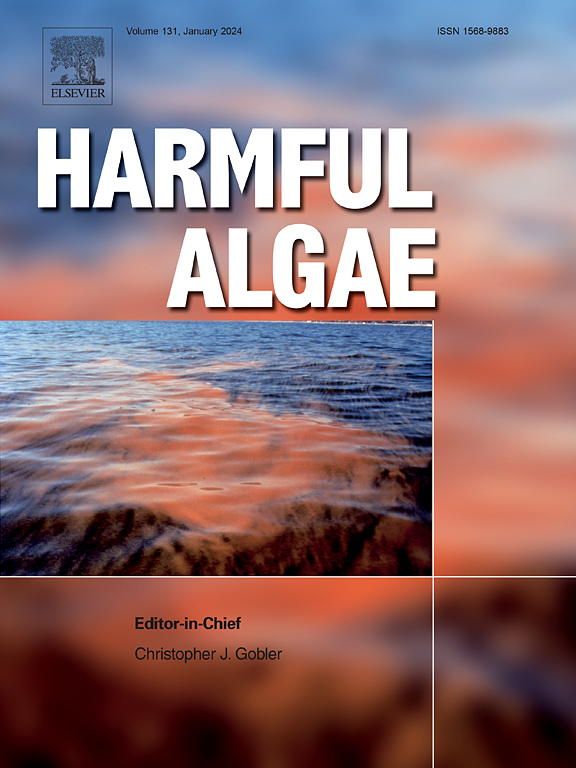Microcystin contamination of shellfish along the freshwater-to-marine continuum within US mid-Atlantic and Northeast estuaries
IF 4.5
1区 生物学
Q1 MARINE & FRESHWATER BIOLOGY
引用次数: 0
Abstract
Estuaries are dynamic ecosystems that are an important habitat for bivalves. The freshwater bodies that discharge into estuaries can introduce cyanobacteria and cyanotoxins that may accumulate within food webs. Microcystin is a hepatotoxin that causes adverse health effects in humans and can be harmful to terrestrial and aquatic organisms. Microcystin has been detected in marine bivalves and the rate of microcystin accumulation and depuration differs between bivalve species. No study has explored the presence or dynamics of microcystins in bivalves in the Northeast US, where they represent a major fishery. This study quantified levels of microcystins in wild and cultured bivalves as a time series from 2017 to 2021 in three of the largest US East Coast estuaries (Chesapeake Bay, the Hudson River Estuary, and Long Island Sound) that have hosted microcystin-producing cyanobacterial harmful algal blooms (CHABs) within their watersheds. During this study, microcystins were rarely detected in bivalves across Chesapeake Bay but were commonly quantified in multiple bivalve species in the Hudson River estuary and within two harbors of Long Island Sound, Stony Brook Harbor and Conscience Bay. Microcystins were detected in clams (Mercenaria mercenaria and Corbicula fluminea), Eastern oysters (Crassostrea virginica), and mussels (Mytilus edulis and Geukensia demissa). Eastern oysters (C. virginica) had significantly higher levels of microcystin than other bivalve species (p < 0.05) and often contained microcystin even when other bivalves sampled concurrently did not, suggesting oysters may be a vector for hepatotoxic shellfish poisoning in estuaries. Microcystins were detected in oysters even in fall months after water column cyanobacterial biomass and microcystins had decreased to low levels, suggesting toxin depuration slows during colder months. Collectively, this study demonstrates that microcystin accumulation in estuarine bivalves, particularly Eastern oysters (C. virginica), occurs within several of the larger US East Coast estuaries and could represent a public health risk.
微囊藻毒素污染贝类沿淡水到海洋连续在美国大西洋中部和东北河口
河口是动态生态系统,是双壳类动物的重要栖息地。排入河口的淡水水体可以引入可能在食物网中积累的蓝藻细菌和蓝藻毒素。微囊藻毒素是一种肝毒素,可对人类健康造成不利影响,并可能对陆生和水生生物有害。在海洋双壳类中检测到微囊藻毒素,微囊藻毒素的积累和净化速度因双壳类而异。没有研究探索微囊藻毒素在美国东北部双壳类动物中的存在或动态,在那里它们代表着一个主要的渔业。这项研究量化了2017年至2021年美国东海岸三个最大的河口(切萨皮克湾、哈德逊河河口和长岛湾)野生和养殖双壳类动物中微囊藻毒素的水平,这些河口在其流域内有产生微囊藻毒素的蓝藻有害藻华(CHABs)。在本研究中,在切萨皮克湾的双壳类动物中很少检测到微囊藻毒素,但在哈德逊河河口和长岛湾、石溪港和良心湾两个港口内的多种双壳类动物中普遍检测到微囊藻毒素。微囊藻毒素在蛤蜊(Mercenaria Mercenaria和Corbicula fluinea)、东方牡蛎(Crassostrea virginica)和贻贝(Mytilus edulis和Geukensia desmissa)中检测到。东方牡蛎(C. virginica)的微囊藻毒素水平显著高于其他双壳类(p <;0.05),而且通常含有微囊藻毒素,即使同时取样的其他双壳类不含微囊藻毒素,这表明牡蛎可能是河口贝类肝毒性中毒的载体。在水柱蓝藻生物量和微囊藻毒素下降到较低水平后,即使在秋季的几个月里,牡蛎中也检测到微囊藻毒素,这表明毒素的净化在较冷的月份减慢。总的来说,这项研究表明,微囊藻毒素在河口双壳类动物,特别是东部牡蛎(C. virginica)中的积累,发生在美国东海岸几个较大的河口内,可能构成公共健康风险。
本文章由计算机程序翻译,如有差异,请以英文原文为准。
求助全文
约1分钟内获得全文
求助全文
来源期刊

Harmful Algae
生物-海洋与淡水生物学
CiteScore
12.50
自引率
15.20%
发文量
122
审稿时长
7.5 months
期刊介绍:
This journal provides a forum to promote knowledge of harmful microalgae and macroalgae, including cyanobacteria, as well as monitoring, management and control of these organisms.
 求助内容:
求助内容: 应助结果提醒方式:
应助结果提醒方式:


